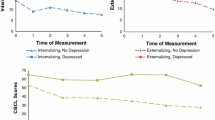Abstract
The effect of a short-term residential therapeutic intervention on childhood depression was investigated. Treatment subjects (N=99; 8 to 12 years old) were children with severe behavior problems and learning disabilities. These children were predominantly from broken homes, low socioeconomic backgrounds, and were considered culturally and socially deprived. Comparison subjects (N=27; 8 to 12 yearsold) were drawn from a traditional school setting as similar as possible to that of the treatment subjects. Pre and posttesting was conducted with the Reynolds Childhood Depression Scale. Specifically, it was hypothesized that depression levels of the treatment group would significantly decrease, while depression levels of the comparison subjects would not. Statistical results show substantial support for this hypothesis in that, in contrast with the comparison groups, the depression levels of the treatment subjects did in fact decrease significantly.
Similar content being viewed by others
References
Alpher, J. (1986). Depression at an early age. In H.E. FitzGerald & M. G. Walraven (Eds.),Human Development 88/89 (pp. 76–79). Guilford, Connecticut: Dushkin.
Banzett, L. K., Liberman, R. P., Moore, J. W., & Marshall, B. D. (1984). Long-term follow-up of the effects of behavior therapy.Hospital and Community Psychiatry, 35(3), 277–279.
Bar-Tal, D., Kfir, D., Bar-Zohar, Y., & Chen, M. (1980). The relationship between locus of control and academic achievement, anxiety, and level of aspiration.British Journal of Educational Psychology, 50, 53–60.
Barth, R. P. (1986).Social and cognitive treatment of children and adolescents. San Francisco: Jossey-Bass.
Battle, J. (1988).North American Depression Inventory for Children. Seattle, WA: Special Child Publications.
Battle, J., Jarratt, L., Smit, S., & Precht, D. (1988). Relations among self-esteem, depression and anxiety of children.Psychological Reports, 62, 999–1005.
Beer, J. (1989). Relationships of divorce to self-concept, self-esteem, and grade point average of fifth and sixth grade school children.Psychological Reports, 65, 1379–1383.
Blumberg, M. L. (1981). Depression in abused and neglected children.American Journal of Psychotherapy, 35(3), 342–355.
Bowlby, J. (1960). Grief and mourning in infancy and early childhood.Psychoanalytic Study of the Child, 15, 9–52.
Breen, D. T. (1987).Changing family structure: An intervention study in the schools. Unpublished dissertation, University of Wisconsin-Madison.
Cantwell, D. P., & Carlson, G. A. (Eds.) (1983).Affective disorders in childhood and adolescence, New York: SP Medical & Scientific Books.
Costello, C. G. (1976).Anxiety and depression. Montreal: McGill-Queen's.
Freden, L. (1982).Psychosocial aspects of depression. New York: John Wiley & Sons.
Kaslow, N. J., & Racusin, G. R. (1990). Childhood depression: Current status and future directions. In A. S. Bellack, M. Hersen, & A. E. Kazdin (Eds.),International Handbook of Behavior Modification and Therapy, 2nd ed New York: Plenum.
Kazdin, A. E. (1988). Childhood depression. In E. J. Mash & L. G. Terdal (Eds.),Behavioral Assessment of Childhood Disorders, 2nd ed. New York: Guilford.
Kazdin, A. E. (1989). Identifying depression in children: A comparison of alternative selection criteria.Journal of Abnormal Child Psychology, 17, 437–454.
Kazdin, A. E. (1990). Childhood depression.Journal of Child Psychology and Psychiatry, 31, 121–160.
Kazdin, A. E., Esveldt-Dawson, K., Sherick, R. B., & Colbus, D. (1985). Assessment of overt behavior and childhood depression among psychiatrically disturbed children.Journal of Consulting and Clinical Psychology, 53, 201–210.
Kovacs, M. (1989). Affective disorder in children and adolescents.American Psychologist, 44, 209–215.
McIntosh, D. & Rawson, H. (1987). Effects of a structured behavior modification treatment program on locus of control in behaviorally disturbed children.The Journal of Genetic Psychology, 149(1), 45–51.
Petti, T. A. (1989). Depression. In T. H. Ollendick & M. Hersen (Eds.),Handbook of Child Psychopathology, 2nd ed. New York: Plenum.
Pugh-Antich, J. (1986). Psychobiological markers: Effects of age and puberty. In M. Rutter, C. E. Izard, & P. B. Read (Eds.),Depression in Young People: Developmental and Clinical Perspectives. New York: Guilford.
Rawson, H. E. (1978). Short-term residential therapeutic camping for behaviorally-disordered children aged 6–12: an academic remediation and behavior modification approach.Therapeutic Recreation Journal, 12(4), 17–23.
Rawson, H. E., & Barnett, T. (in press). Changes in children's manifest anxiety in a therapeutic short-term camping experience: an exploratory study.Therapeutic Recreation Journal.
Rawson, H. E. (in press). The interrelationships of measures of manifest anxiety, selfesteem, locus of control and depression in children with learning difficulties.Journal of Psychoeducational Assessment.
Rawson, H. E., & McIntosh, D. (1991). Does camping really lead to changes in selfesteem?Camping magazine, 63(6). 18–21.
Rawson, H. E., & McIntosh, D. (1991). The effects of therapeutic camping on the selfesteem of children with severe behavior disorders.Therapeutic Recreation Journal, 25(4), 41–49.
Reynolds, M.R. (1989).Reynolds Childhood Depression Scale. USA: Psychological Assessment Resources.
Rutter, M. (1986). The developmental psychopathology of depression: Issues and perspectives. In M. Rutter, C. E. Izard, & P. B. Read (Eds.),Depression in Young People: Developmental and Clinical Perspectives. New York: Guilford.
Rutter, M., Izard, C. E., & Read, P. B. (Eds.) (1986).Depression in Young People: Developmental and Clinical Perspectives. New York, Guilford.
Saarni, C., & Harris, P. (Eds.) (1989).Children's understanding of emotion, New York: Cambridge University Press.
Shaw, J. A. (1988). Childhood depression.Medical Clinics of North America, 72, 831–845.
Spitz, R. A. (1946). Anaclitic depression. In thePsychoanalytic Study of the Child, Vol. 2. New York: International Universities Press.
Weisz, J. R., Weiss, K. S., Wasserman, A. A., & Rintoul, B. (1987). Control-related beliefs and depression among clinic-referred children and adolescents.Journal of Abnormal Psychology, 96(1), 58–63.
Author information
Authors and Affiliations
Rights and permissions
About this article
Cite this article
Rawson, H.E., Tabb, L.C. Effects of therapeutic intervention on childhood depression. Child Adolesc Soc Work J 10, 39–52 (1993). https://doi.org/10.1007/BF00758022
Issue Date:
DOI: https://doi.org/10.1007/BF00758022




